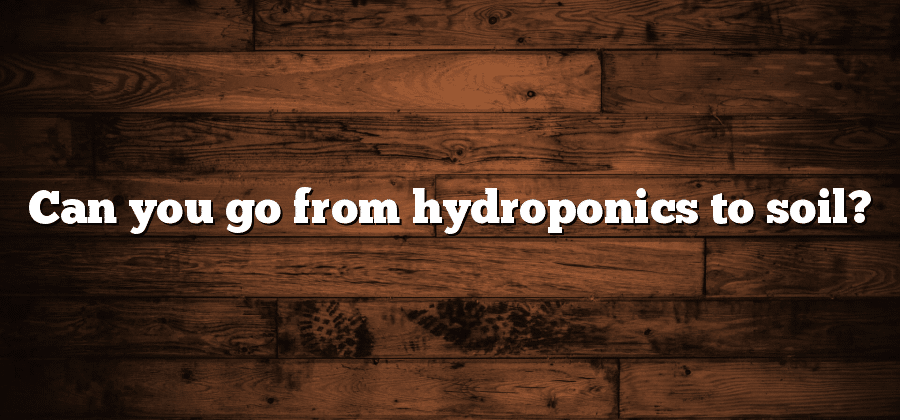Hydroponics Explained
Hydroponics, a revolutionary approach to gardening, is gaining popularity among both enthusiasts and commercial growers. This innovative method eliminates the need for soil, by growing plants directly in water, supplemented with essential nutrients. By providing plants with a controlled environment, hydroponics offers numerous advantages over traditional soil-based gardening.
One key benefit of hydroponics is its ability to maximize space utilization. Without the need for large soil beds, plants can be grown vertically, allowing for more crops in a smaller area. Additionally, hydroponics minimizes water usage compared to soil-based methods, as the water in a hydroponic system is recycled and reused. This not only supports sustainable farming practices but also reduces water waste and the risk of water-borne diseases. Furthermore, since hydroponic plants grow in a controlled environment, they are less susceptible to pests and diseases, leading to higher yields and healthier crops.
Benefits of Hydroponics
Hydroponics, the practice of growing plants without soil, offers numerous benefits that make it an increasingly popular choice for gardening enthusiasts. One of the main advantages of hydroponics is that it allows for controlled and precise nutrient delivery to the plants. By directly providing the necessary minerals and elements to the roots, hydroponic systems ensure optimal growth and development. This targeted approach eliminates the risk of nutrient deficiencies or excesses often associated with traditional soil gardening.
Another significant benefit of hydroponics is its water efficiency. Unlike soil-based gardening, which requires a significant amount of water to maintain the right moisture levels, hydroponics systems use water more sparingly. The water in a hydroponic setup is recirculated, meaning it is continuously reused, reducing wastage. This not only conserves water but also lowers the overall cost of irrigation. Additionally, by eliminating the need for soil, hydroponics minimizes the risk of weed growth and soil-borne diseases, resulting in healthier and more productive plants.
Understanding Soil-Based Gardening
Soil-based gardening is a traditional and widely practiced method of growing plants. It involves cultivating plants in the ground, utilizing the nutrients and structure of the soil to support their growth. This method has been used for centuries and is often preferred by gardeners who appreciate the natural connection between plants and the earth.
One of the key aspects of soil-based gardening is the ability of the soil to provide essential nutrients to the plants. The soil contains minerals that are necessary for plant growth, such as nitrogen, phosphorus, and potassium. These nutrients are released gradually as the organic matter in the soil decomposes, allowing the plants to absorb them through their roots. Soil-based gardening also benefits from the natural microbial activity in the soil, which helps break down organic matter and make nutrients more readily available to the plants. This natural symbiotic relationship between the soil and the plants contributes to their overall health and productivity.
Challenges when Transitioning Methods
One of the major challenges faced when transitioning from hydroponics to soil-based gardening is the adjustment in watering techniques. In hydroponics, plants are typically watered directly through a nutrient-rich solution that flows continuously through their root systems. However, when shifting to soil-based gardening, plants rely on natural rainfall or manual watering, requiring a different approach and careful monitoring of moisture levels. Neglecting to provide adequate water to the plants can result in stunted growth, wilting, and even plant death. On the other hand, over-watering can lead to root rot and other fungal diseases. Therefore, it is crucial to find a balance by understanding the water requirements of different plant species and adjusting watering practices accordingly.
Another challenge when transitioning to soil-based gardening is the variation in nutrient availability. In hydroponics, nutrients are precisely measured and delivered directly to the plants’ root systems, ensuring optimal growth. In soil-based gardening, the nutrient content in the soil may vary depending on factors like soil type, composition, and previous fertilization practices. This requires a thorough understanding of the soil’s nutrient profile and the nutritional requirements of the plants being grown. Failing to provide adequate nutrients can result in nutrient deficiencies, leading to overall plant weakness, poor yield, and susceptibility to pests and diseases. Consequently, it is essential to regularly test the soil and make necessary adjustments by adding organic matter or using appropriate fertilizers to maintain a healthy nutrient balance for successful soil-based gardening.
Preparing Plants for Soil-Based Gardening
Preparing Plants for Soil-Based Gardening
When transitioning from hydroponics to soil-based gardening, it is essential to properly prepare your plants to ensure their successful adaptation. The key to this preparation lies in gradually acclimating the plants to their new environment. This can be achieved by introducing small amounts of soil to the roots of the plants while they are still in the hydroponic system. By doing so, the plants will have the opportunity to slowly adjust to the different texture, structure, and nutrient composition of the soil.
In addition to gradually introducing soil, it is important to pay attention to the watering and fertilization needs of the plants during this transition period. The moisture levels and nutrient requirements of soil-based gardening are typically different from those of hydroponics. Therefore, it is crucial to closely monitor and adjust the watering and fertilization routines accordingly. Overwatering or overfeeding the plants can lead to nutrient imbalances or root rot, which can significantly hinder their ability to thrive in the soil.
By following these steps and providing the necessary care, you can effectively prepare your plants for soil-based gardening. However, it is important to remember that each plant may respond differently to the transition process, so patience and careful observation are key. With proper preparation, your plants will have a better chance of adapting to their new growing medium and flourishing in your soil-based garden.






